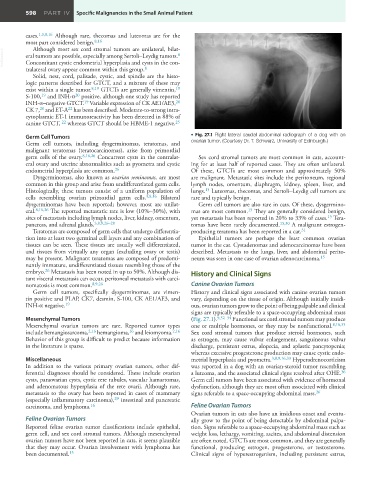Page 620 - Withrow and MacEwen's Small Animal Clinical Oncology, 6th Edition
P. 620
598 PART IV Specific Malignancies in the Small Animal Patient
cases. 1,3,8,16 Although rare, thecomas and luteomas are for the
most part considered benign. 8,16
Although most sex cord stromal tumors are unilateral, bilat-
VetBooks.ir eral tumors are possible, especially among Sertoli–Leydig tumors.
8
Concomitant cystic endometrial hyperplasia and cysts in the con-
tralateral ovary appear common within this group. 8
Solid, nest, cord, palisade, cystic, and spindle are the histo-
logic patterns described for GTCT, and a mixture of these may
19
exist within a single tumor. 8,19 GTCTs are generally vimentin,
S-100, and INH-α positive, although one study has reported
19
20
INH-α–negative GTCT. Variable expression of CK AE1/AE3,
19
20
22
CK 7, and ET-A has been described. Moderate-to-strong intra-
20
cytoplasmic ET-1 immunoreactivity has been detected in 88% of
25
22
canine GTCT, whereas GTCT should be HBME-1 negative.
Germ Cell Tumors • Fig. 27.1 Right lateral caudal abdominal radiograph of a dog with an
Germ cell tumors, including dysgerminomas, teratomas, and ovarian tumor. (Courtesy Dr. T. Schwarz, University of Edinburgh.)
malignant teratomas (teratocarcinomas), arise from primordial
germ cells of the ovary. 8,16,26 Concurrent cysts in the contralat- Sex cord stromal tumors are most common in cats, account-
eral ovary and uterine abnormalities such as pyometra and cystic ing for at least half of reported cases. They are often unilateral.
endometrial hyperplasia are common. 26 Of these, GTCTs are most common and approximately 50%
Dysgerminomas, also known as ovarian seminomas, are most are malignant. Metastatic sites include the peritoneum, regional
common in this group and arise from undifferentiated germ cells. lymph nodes, omentum, diaphragm, kidney, spleen, liver, and
Histologically, these tumors consist of a uniform population of lungs. Luteomas, thecomas, and Sertoli–Leydig cell tumors are
15
cells resembling ovarian primordial germ cells. 3,8,16 Bilateral rare and typically benign.
dysgerminomas have been reported; however, most are unilat- Germ cell tumors are also rare in cats. Of these, dysgermino-
eral. 8,16,26 The reported metastatic rate is low (10%–30%), with mas are most common. They are generally considered benign,
15
sites of metastasis including lymph nodes, liver, kidney, omentum, yet metastasis has been reported in 20% to 33% of cases. Tera-
15
pancreas, and adrenal glands. 3,8,9,26–28 tomas have been rarely documented. 15,30 A malignant estrogen-
Teratomas are composed of germ cells that undergo differentia- producing teratoma has been reported in a cat. 31
tion into at least two germinal cell layers and any combination of Epithelial tumors are perhaps the least common ovarian
tissues can be seen. These tissues are usually well differentiated, tumor in the cat. Cystadenomas and adenocarcinomas have been
and tissues from virtually any organ (excluding ovary or testis) described. Metastasis to the lungs, liver, and abdominal perito-
may be present. Malignant teratomas are composed of predomi- neum was seen in one case of ovarian adenocarcinoma.
15
nantly immature, undifferentiated tissues resembling those of the
26
embryo. Metastasis has been noted in up to 50%. Although dis- History and Clinical Signs
tant visceral metastasis can occur, peritoneal metastasis with carci-
nomatosis is most common. 8,9,26 Canine Ovarian Tumors
Germ cell tumors, specifically dysgerminomas, are vimen- History and clinical signs associated with canine ovarian tumors
tin positive and PLAP, CK7, desmin, S-100, CK AE1/AE3, and vary, depending on the tissue of origin. Although initially insidi-
19
INH-α negative. ous, ovarian tumors grow to the point of being palpable and clinical
signs are typically referable to a space-occupying abdominal mass
Mesenchymal Tumors (Fig. 27.1). 9,32–34 Functional sex cord stromal tumors may produce
Mesenchymal ovarian tumors are rare. Reported tumor types one or multiple hormones, or they may be nonfunctional. 8,16,35
16
include hemangiosarcoma, 2,16 hemangioma, and leiomyoma. 2,16 Sex cord stromal tumors that produce steroid hormones, such
Behavior of this group is difficult to predict because information as estrogen, may cause vulvar enlargement, sanguineous vulvar
in the literature is sparse. discharge, persistent estrus, alopecia, and aplastic pancytopenia;
whereas excessive progesterone production may cause cystic endo-
Miscellaneous metrial hyperplasia and pyometra. 3,8,9,16,33 Hyperadrenocorticism
In addition to the various primary ovarian tumors, other dif- was reported in a dog with an ovarian-steroid tumor resembling
ferential diagnoses should be considered. These include ovarian a luteoma, and the associated clinical signs resolved after OHE.
36
cysts, paraovarian cysts, cystic rete tubules, vascular hamartomas, Germ cell tumors have been associated with evidence of hormonal
and adenomatous hyperplasia of the rete ovarii. Although rare, dysfunction, although they are most often associated with clinical
metastasis to the ovary has been reported in cases of mammary signs referable to a space-occupying abdominal mass.
26
(especially inflammatory carcinoma), intestinal and pancreatic
29
16
carcinoma, and lymphoma. Feline Ovarian Tumors
Ovarian tumors in cats also have an insidious onset and eventu-
Feline Ovarian Tumors ally grow to the point of being detectable by abdominal palpa-
Reported feline ovarian tumor classifications include epithelial, tion. Signs referable to a space-occupying abdominal mass such as
germ cell, and sex cord stromal tumors. Although mesenchymal weight loss, lethargy, vomiting, ascites, and abdominal distension
ovarian tumors have not been reported in cats, it seems plausible are often noted. GTCTs are most common, and they are generally
that they may occur. Ovarian involvement with lymphoma has functional, producing estrogen, progesterone, or testosterone.
been documented. 15 Clinical signs of hyperestrogenism, including persistent estrus,

